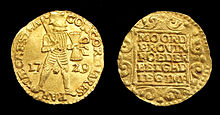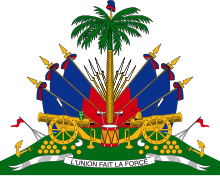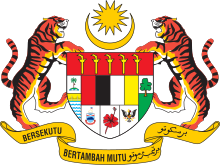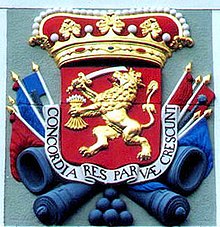Fasces is a bound bundle of wooden rods, often but not always including an axe with its blade emerging. The fasces is an Italian symbol that had its origin in the Etruscan civilization and was passed on to ancient Rome, where it symbolized a Roman king's power to punish his subjects, and later, a magistrate's power and jurisdiction. The axe has its own separate and older origin. Initially associated with the labrys, the double-bitted axe originally from Crete, is one of the oldest symbols of Greek civilization.

The coat of arms of Belgium bears a lion or, known as Leo Belgicus, as its charge. This is in accordance with article 193 of the Belgian Constitution: The Belgian nation takes red, yellow and black as colours, and as state coat of arms the Belgian lion with the motto UNITY MAKES STRENGTH. A royal decree of 17 March 1837 determines the achievement to be used in the greater and the lesser version, respectively.

The flag of Haiti is the national flag of the Republic of Haiti. It is a bicolour flag featuring two horizontal bands coloured blue and red, emblazoned by a white rectangular panel bearing the coat of arms of Haiti. The coat of arms depicts a trophy of weapons atop a green hill and a royal palm symbolizing independence. The palm is topped by the Cap of Liberty. The motto L'Union fait la Force appears on a white ribbon below the arrangement.

The coat of arms of Bulgaria consists of a crowned golden lion rampant over a dark red shield; above the shield is the Bulgarian historical crown. The shield is supported by two crowned golden lions rampant; below the shield there is compartment in the shape of oak twigs and white bands with the national motto "Unity makes strength" inscribed on them.

The Order of Leopold is one of the three current Belgian national honorary orders of knighthood. It is the oldest and highest order of Belgium and is named in honour of its founder, King Leopold I. It consists of a military, a maritime and a civil division. The maritime division is only awarded to personnel of the merchant navy, and the military division to military personnel. The decoration was established on 11 July 1832 and is awarded by Royal decree.
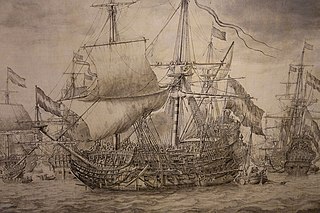
The Eendracht or Eendragt was the flagship of the confederate navy of the United Provinces between 1655 and 1665. Eendragt was the more common spelling in the 17th century; Eendracht is the modern Dutch standard spelling.
The Eendracht was an early 17th century Dutch wooden-hulled 700 tonne East Indiaman, launched in 1615 in the service of the Dutch East India Company (VOC). Its Dutch name means "concord", "unity" or "union", and was a common name given to Dutch ships of the period, from the motto of the Republic: Concordia res parvae crescunt . The ship was captained by Dirk Hartog when he made the second recorded landfall by a European on Australian soil, in 1616.
Eendracht is a canal and former branch of the river Scheldt in the Netherlands.
The Order of Leopold II is an order of Belgium and is named in honor of King Leopold II. The decoration was established on 24 August 1900 by Leopold II as Sovereign of the Congo Free State and was in 1908, upon Congo being handed over to Belgium, incorporated into the Belgian awards system. The order is awarded for meritorious service to the sovereign of Belgium, and as a token of his personal goodwill. It can be awarded to both Belgians and foreigners, and is seen as diplomatic gift of merit.
L'Union fait la force is a French language game show airing weekdays on Ici Radio-Canada Télé. It is hosted by Patrice L'Écuyer.
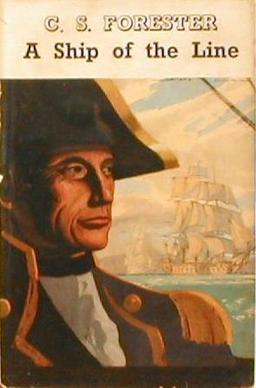
A Ship of the Line is an historical seafaring novel by C. S. Forester. It follows his fictional hero Horatio Hornblower during his tour as captain of a ship of the line. By internal chronology, A Ship of the Line, which follows The Happy Return, is the seventh book in the series. However, the book, published in 1938, was the second Hornblower novel completed by Forester. It is one of three Hornblower novels adapted into the 1951 British-American film Captain Horatio Hornblower R.N..

The coat of arms of Haiti is the national coat of arms of the Republic of Haiti. It was originally introduced in 1807, and it has appeared in its current form since 1986. Since this Haitian national symbol does not conform to the rules of heraldry for a traditional coat of arms, then it could be considered a national emblem instead.

The coat of arms of the Transvaal was the official heraldic symbol of the South African Republic from 1866 to 1877 and again from 1881 to 1902, and later the symbol of the Transvaal Province from 1954 to 1994 in a simplified form. It is now obsolete.

The Dutch Republic Lion was the badge of the Union of Utrecht, the Republic of the Seven United Netherlands, and a precursor of the current coat of arms of the Kingdom the Netherlands.
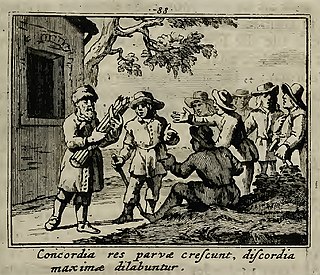
The Old Man and his Sons, sometimes titled The Bundle of Sticks, is an Aesop's Fable whose moral is that there is strength in unity. The story has been told about many rulers. It is numbered 53 in the Perry Index.

Ex unitate vires is a Latin phrase formerly used as the national motto of South Africa. It was originally translated as "Union is Strength" but was later revised in 1961 to mean "Unity is Strength". Its Dutch version is "Eendracht maakt macht", itself a non-literal translation of "in concordia res parvae crescunt", originally the motto of the Dutch Republic. That translation, along with its French counterpart - "L'union fait la force" - is also the current motto of Belgium. It was adopted as the national motto of South Africa in 1910 but was replaced in 2000.
